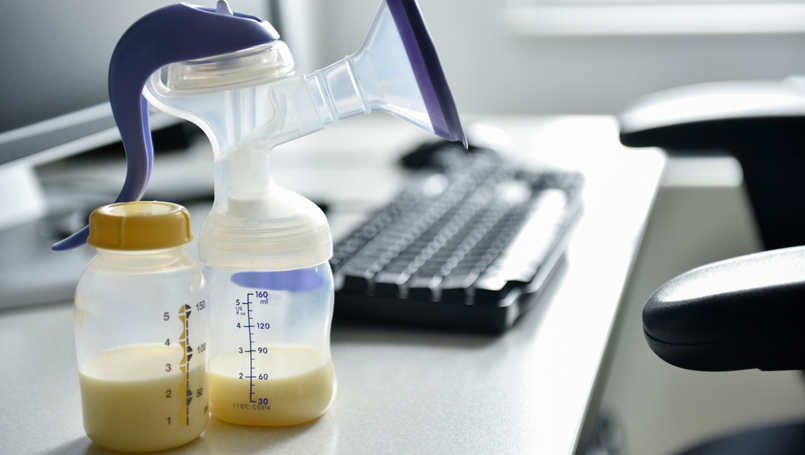Andrea Firmani is a Clinical Nurse Educator in maternity and an International Board Certified Lactation Consultant. She had her three babies at St. Paul’s Hospital and is an advocate for supporting families in early parenthood. Here she shares her tips on supporting the transition from maternity leave to returning to work for breastfeeding and pumping parents.
Returning to work after having a baby comes with an onset of new challenges for parents.
The transition from breastfeeding on baby’s cues to now being separated for a large period of time—possibly for the first time since the baby was born—is a common cause of family stress. How will the baby do without the breastfeeding parent around? Parents may also wonder how they will maintain their milk supply when returning to work.
Both breastfeeding and pumping parents are faced with this transition that naturally comes with heading back to work. Whether that means going back to the office, resuming shift work or being on-call, the rhythm of breastfeeding that naturally happened is now faced with a change.
However, this new separation does not mean that breastfeeding needs to stop.
Planning Your Return to Work
The age of your baby will help determine what you may need to do to get prepared before going back to work. Is your baby under six months old and their main intake is breast milk?
Are you returning around 12 to 18 months and don’t want a dip in your supply?
Each family is faced with different scenarios and we have some tips to help support returning to work.
Protect Your Milk Supply
- If your baby is under six months old, you will need to pump while you are at work to maintain supply. Expressing breast milk is an important strategy to ensure the elegant system of supply and demand continues.
- Store your pumping equipment in a large resealable bag and place it into a refrigerator between uses. You don’t need to clean your pumping parts after each pump session. Take home your pump parts and clean them once every 24-hours.
- Pumping at work can be the opposite of relaxing so tap into the flow of those oxytocin hormones. Look at photos of your baby, bring something with you that smells like them, let your mind wander and think of cuddling your baby. These feel good moments can help trigger oxytocin so milk let down happens.
Use Hand Expression to Get You Through
Between patient care or office deadlines, it is not always feasible to be able to stop and have a pumping session. Sometimes your breasts can become very full and uncomfortable in the middle of something important. Using the technique of hand expression can be helpful in removing a small amount of milk. This will help with your comfort until you are fully able to empty your breasts by pumping or breastfeeding. Even this small removal of milk can help maintain your supply and prevent engorgement.
Expect Changes At Home
It is common for babies and young children to want to nurse more frequently when finally reunited after a long workday. Babies and young children may increase their night wakings to breastfeed. Some babies will do the bulk of their feeding during nighttime and this is a biologically normal change that is temporary.
For some families, incorporating dream feeds can be successful in managing this transition back to work. If your baby is sleeping before you leave for work and is also asleep when you return, consider doing a quiet breastfeed in their sleeping space while they are asleep. This will help to ensure your baby is getting your milk and that your breasts are being emptied. Babies can actively breastfeed without fully waking up.
Bottle/Cup Feeding the Breastfed Baby
One concern families of breastfed babies often have is around introducing bottles.
If your baby has been exclusively feeding at the breast, adding bottles can often result in some level of anticipatory stress for parents. Some babies will show a preference between breastfeeding and bottle-feeding and decline all bottles. This is often related to the flow of milk and less about the type of bottle you bought.
- Have someone other than the breastfeeding parent introduce bottles to the baby.
- If your baby is under six months old, try a paced bottle feeding position so your baby has to do some work to get the milk flowing. This allows the flow to be more similar to breastfeeding.
- If your baby is over six months old, you can start having them practice with an open cup. Start with small amounts of water and let your baby grab the cup and practice. It is messy but a great developmental milestone.
- Babies over 12 months can transition to drinking out of a cup while away at daycare. At this age, your baby can be given water in a cup with their meals. This complement of water is in addition to breastfeeding when you are together.
Above all, remember that breastfeeding is more than nutrition and the act of breastfeeding blends a mix of comfort and soothing for babies and young children. Going back to work and having your baby in daycare is a big parenting milestone. Make sure to give yourself the time and space to adjust to this new normal for your family.





